Media | Articles
What you need to know about asbestos, working on cars, and mesothelioma
Those of us who like to wrench on cars and dive into the world of DIY projects know that getting your hands dirty sometimes means you’ll bust a knuckle, cut yourself, or accidentally curse like a sailor in front of children when you can’t find that damn 10mm socket. That’s all part of the experience, perhaps, but it behooves all of us to take better care when it comes to more serious risks, like making sure to always use jack stands as a backup in case a jack fails, and wearing eye protection to make sure harmful liquids and gasses don’t permanently damage your vision.
With that in mind, February is Lung Cancer Prevention Month, so we’re taking a closer look at how to be safe when working with automotive parts and products that may contain asbestos.
For starters, some background. Asbestos is a mineral that used to be a common component in brake and clutch parts, electrical insulation, heat shields, gaskets, hood liners, as well as in non-automotive applications like construction. It was popular because of its heat resistance and, in the case of braking components, for its properties improving friction. Although asbestos in its solid, natural form is harmless, it was later discovered that when fibers become airborne they cause significantly increased risk for lung diseases like mesothelioma, lung cancer, and asbestosis. Symptoms can take years to develop after exposure.
Australia enforces a full ban on asbestos and asbestos-containing materials. That includes new-old-stock parts as well as any asbestos on any car submitted for import, and the importer has to pay for the Border Force’s testing on suspicious (read: vintage) cars as well as replacement of parts. Fees can stack up like crazy, as you can imagine. Canada also passed a ban on asbestos last year, but it’s unclear if the Canadian border authorities will be scrutinizing vintage cars to the same extent as Australia.
Industry workers regularly exposed to asbestos-rich materials are obviously at much greater risk than DIYers, and the U.S. Department of Labor requires all professional brake and clutch repair facilities to comply with Occupational Safety and Health Administration guidelines on proper best practices to minimize exposure.
Marketplace
Buy and sell classics with confidence
For the shade-tree mechanic, especially when it comes to working on vintage cars, there are still risks to consider and precautions you can take:


Prevent asbestos from becoming airborne
When working with clutch and brake parts, as well as any insulation on vintage cars, the first thing is to minimize the chance for any asbestos to become airborne. If you can, work in a well-ventilated area, and don’t use compressed air for cleaning such parts. If using a vacuum, ensure it has a high-efficiency particulate air filter.
Make sure to use a wet rag or garden hose instead of a brush. The “wet method” recommended by OSHA includes spraying a fine mist or low-pressure water stream to the part in question before removing it, and then wiping it clean with a cloth and placing it in a sealed container for safe disposal (or you can launder it).
Use pre-ground parts
Vintage parts you’re removing may contain asbestos, and anything you buy new must legally contain less than 1 percent asbestos, but it’s still a good idea to use pre-ground parts to minimize the amount of dust in the workspace around you. If you need to grind or cut a part, use low speeds on the lathe, for example, to keep dust levels to a minimum.
Change your clothes
You can’t see airborne asbestos, and it can linger in the air and on your clothes for a while after the job is done. It’s a good idea to change into different clothes at your workspace, so you don’t take asbestos dust with you into the car or house.
For more information on asbestos and mesothelioma, you can visit asbestos.com or mesothelioma.com.










